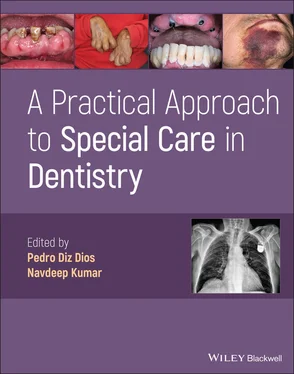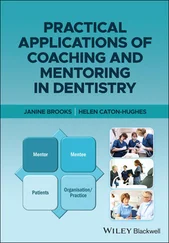A Practical Approach to Special Care in Dentistry
Здесь есть возможность читать онлайн «A Practical Approach to Special Care in Dentistry» — ознакомительный отрывок электронной книги совершенно бесплатно, а после прочтения отрывка купить полную версию. В некоторых случаях можно слушать аудио, скачать через торрент в формате fb2 и присутствует краткое содержание. Жанр: unrecognised, на английском языке. Описание произведения, (предисловие) а так же отзывы посетителей доступны на портале библиотеки ЛибКат.
- Название:A Practical Approach to Special Care in Dentistry
- Автор:
- Жанр:
- Год:неизвестен
- ISBN:нет данных
- Рейтинг книги:3 / 5. Голосов: 1
-
Избранное:Добавить в избранное
- Отзывы:
-
Ваша оценка:
- 60
- 1
- 2
- 3
- 4
- 5
A Practical Approach to Special Care in Dentistry: краткое содержание, описание и аннотация
Предлагаем к чтению аннотацию, описание, краткое содержание или предисловие (зависит от того, что написал сам автор книги «A Practical Approach to Special Care in Dentistry»). Если вы не нашли необходимую информацию о книге — напишите в комментариях, мы постараемся отыскать её.
Learn to treat dental patients with disabilities or who are medically compromised A Practical Approach to Special Care in Dentistry
A Practical Approach to Special Care in Dentistry
A Practical Approach to Special Care in Dentistry — читать онлайн ознакомительный отрывок
Ниже представлен текст книги, разбитый по страницам. Система сохранения места последней прочитанной страницы, позволяет с удобством читать онлайн бесплатно книгу «A Practical Approach to Special Care in Dentistry», без необходимости каждый раз заново искать на чём Вы остановились. Поставьте закладку, и сможете в любой момент перейти на страницу, на которой закончили чтение.
Интервал:
Закладка:
Stage 2: Latency period/chronic infectionGenerally characterised by persistent generalised lymphadenopathyCan also be asymptomatic until the first opportunistic infections appear, such as oral candidiasisVery low viral load; if taking antiretroviral therapy, viral load may be undetectable with effectively no risk of viral transmission
Stage 3: AIDSCharacterised by the onset of conditions that have been called ‘AIDS‐defining’These include oesophageal candidiasis, systemic mycosis (histoplasmosis, coccidioidomycosis, cryptococcosis), cerebral toxoplasmosis, pneumonia by Pneumocystis carinii ( Figure 4.2.5), retinitis by Cytomegalovirus, encephalitis by HIV, tuberculosis and extrapulmonary infections by non‐tuberculosis Mycobacterium, cervical cancer, Kaposi sarcoma, lymphoma, progressive multifocal leucoencephalopathy and HIV wasting syndrome
Diagnosis
The initial diagnostic test is the enzyme‐linked immunosorbent assay (ELISA), which detects the viral protein p24, an HIV‐1 antigen; there can be a window of up to 6 months from exposure to the virus to when it becomes detectable
If the ELISA is positive, the HIV‐1/HIV‐2 antibody differentiation immunoassay confirmation test is applied (Western Blot, which was used prior to this test, could not differentiate between HIV‐1 and HIV‐2). If the result is negative or indeterminate, the nucleic acid test (NAT) may be employed to confirm that this is not an acute infection or a false positive Figure 4.2.5 Pneumonia by Pneumocystis carinii as an AIDS‐defining condition.
Rapid HIV antibody detection tests have been marketed and employ samples of oral mucosa exudate
The immunosuppression level is established based on the concentration of CD4+ T‐cells in peripheral blood and is the best predictor available for the onset of opportunistic infections, disease progression and survival (stage 1, ≥500 cells/μL; stage 2, 200–499 cells/μL; stage 3, <200 cells/μL)
Determining the viral load consists of quantifying the number of copies of HIV ribonucleic acid (HIV‐RNA) in peripheral blood, using the real‐time polymerase chain reaction (RT‐PCR); this test is applied as a predictor of disease progression and to select the antiretroviral regimen
A patient is considered to be in the AIDS stage when they have <200 CD4+ T‐cells/μL, their CD4+ T‐cell count is <14% of the total or they have an AIDS‐defining condition
Management
ART (antiretroviral therapy) is the combination of several antiretroviral agents, and should be commenced as soon as possible after diagnosis
Antiretrovirals seek to reduce the viral load (below 20–50 copies/mL is considered undetectable, depending on the test employed), increase the CD4+ T‐cell count, prevent opportunistic infections and reduce transmission to others
The most widely used families of antiretrovirals are:Nucleoside/nucleotide reverse transcriptase inhibitors (NRTI)Non‐nucleoside reverse transcriptase inhibitors (NNRTI)Protease inhibitors (PI)Entry or fusion inhibitorsIntegrase strand transfer inhibitors (INSTIs)
An initial HIV drug regimen typically includes 3 HIV medications from 2 or more different drug classes:Two NRTIs with an INSTI, NNRTI, or PIRitonavir (PI) or cobicistat as a booster (cytochrome P450 3A inhibitor)
The regime varies according to the patient's response and associated side‐effects
ART is associated with adverse effects that are not always predictable and include:Nausea and vomiting, diarrhoea, difficulty sleeping, dry mouth, headache, rash, dizziness, fatigue, and painThrombocytopenia caused by ritonavir
Prognosis
The main markers of disease progression are CD4+ T helper cell counts and the HIV replication rate (viral load)
The life expectancy of individuals with HIV infection who do not undergo ART is 2–3 years
About 85% of patients who undergo ART survive for more than 10 years
A World/Transcultural View
Africa remains the most affected region of the world due to HIV infection/AIDS, especially the sub‐Saharan region in which more than 30 million infected individuals live
The prevalence of HIV‐associated oral lesions remains significant in low‐income countries. Hairy leucoplakia is more common in Europe and America than in Africa and Asia. Paradoxically, the prevalence of salivary gland disease has decreased in the industrialised world and increased in low‐income countries
Dentists' willingness to provide dental treatment to patients with HIV varies depending on the dentists' origin and country in which they were trained
Recommended Reading
1 Diz Dios, P. and Scully, C. (2014). Antiretroviral therapy: effects on orofacial health and health care. Oral Dis. 20: 136–145.
2 Gay‐Escoda, C., Pérez‐Álvarez, D., Camps‐Font, O., and Figueiredo, R. (2016). Long‐term outcomes of oral rehabilitation with dental implants in HIV‐positive patients: a retrospective case series. Med. Oral Patol. Oral Cir. Bucal 21: e385–e391.
3 Ghosn, J., Taiwo, B., Seedat, S. et al. (2018). HIV. Lancet 392: 685–697.
4 Patton, L.L., Shugars, D.A., and Bonito, A.J. (2002). A systematic review of complication risks for HIV‐positive patients undergoing invasive dental procedures. J. Am. Dent. Assoc. 133: 195–203.
5 Porter, S.R., Luker, J., Scully, C., and Kumar, N. (1999). Oral lesions in UK patients with or liable to HIV disease‐ten years experience. Med. Oral 4: 455–469.
6 Robbins, M.R. (2017). Recent recommendations for management of Human Immunodeficiency Virus‐positive patients. Dent. Clin. North Am. 61: 365–387.
7 Santella, A.J. (2020). HIV testing in the dental setting: a global perspective of feasibility and acceptability. Oral Dis. 26: S34–S39.
4.3 Viral Hepatitis
Section I: Clinical Scenario and Dental Considerations
Clinical Scenario
A 74‐year‐old man attends to your clinic for an emergency appointment. He complains of a painful lump in the gum adjacent to the upper left first molar (#26) that presented 24 hours earlier and is getting worse.
Medical History
Moderate chronic hepatitis C (the patient declined treatment with direct‐acting antivirals [DAAs] due to a poor previous experience with interferon)
Thrombocytopenia (65 000 platelets/μL)
Arterial hypertension
Chronic obstructive pulmonary disease (exertional dyspnea)
Anxiety‐depression syndrome
Road traffic accident in 1988 resulting in a ruptured spleen and a mandibular fracture due to a work accident 40 years earlier – received blood transfusions
Splenectomy in 1988
Medications
Telmisartan
Alprazolam (recently commenced)
Beclomethasone
Dental History
It has been 40 years since the patient attended a dental clinic (only went at the time due to his mandibular fracture)
Admits being afraid of dentists due to a bad experience when he was a child
Does not brush his teeth regularly
Social History
Married and lives with his wife (drives his own vehicle)
Retired
Ex‐smoker (20 cigarettes/day until 4 years ago); alcohol – nil
Oral Examination
Poor oral hygiene
Missing teeth: #16, #17, #24 and #25
Periodontal abscess associated with tooth #26, which extends to the buccal sulcus
Caries in #26, #36, #47 and #48
Radiological Examination
Orthopantomogram undertaken ( Figure 4.3.1)
Generalised alveolar bone loss
Extensive, deep and unrestorable caries in #26
Читать дальшеИнтервал:
Закладка:
Похожие книги на «A Practical Approach to Special Care in Dentistry»
Представляем Вашему вниманию похожие книги на «A Practical Approach to Special Care in Dentistry» списком для выбора. Мы отобрали схожую по названию и смыслу литературу в надежде предоставить читателям больше вариантов отыскать новые, интересные, ещё непрочитанные произведения.
Обсуждение, отзывы о книге «A Practical Approach to Special Care in Dentistry» и просто собственные мнения читателей. Оставьте ваши комментарии, напишите, что Вы думаете о произведении, его смысле или главных героях. Укажите что конкретно понравилось, а что нет, и почему Вы так считаете.












